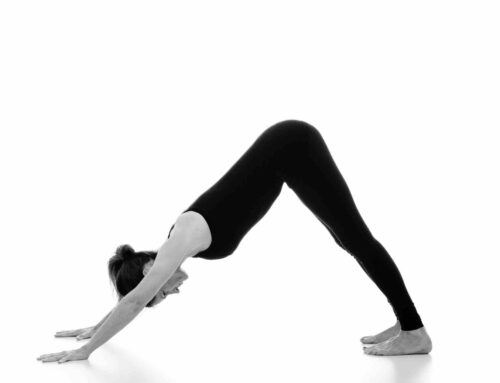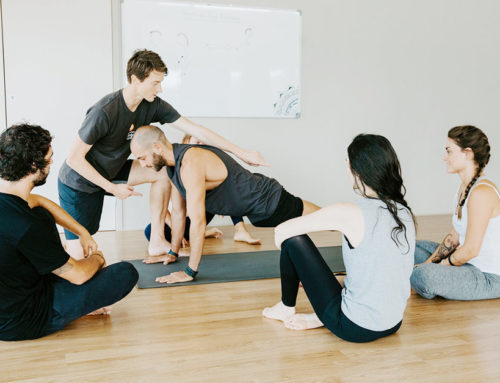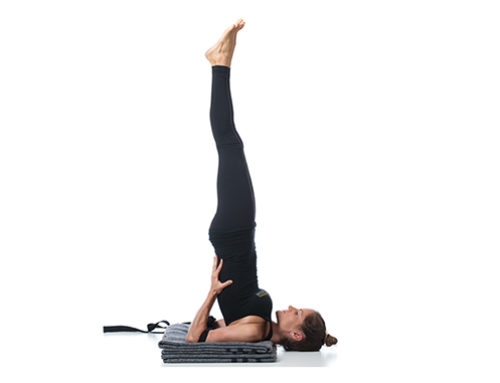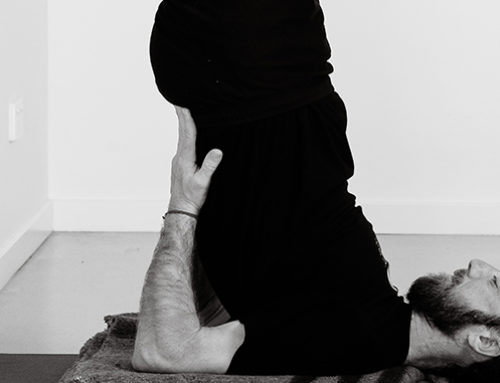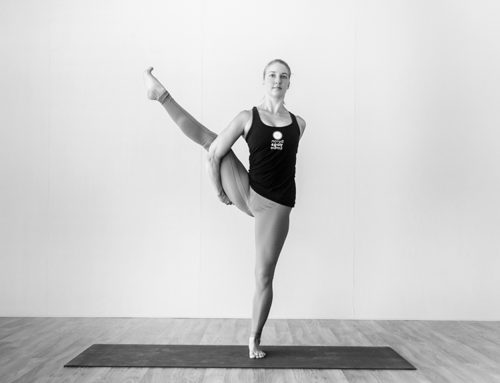Written by Kara Goodsell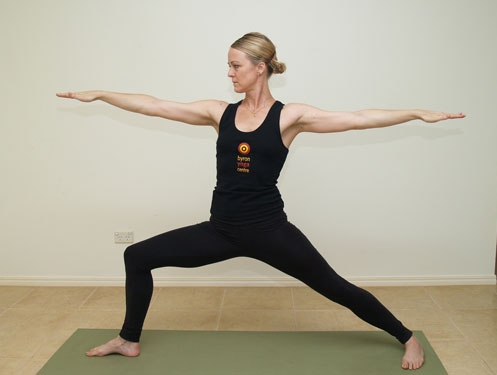
Virabhadrasana II, a basic asymmetrical standing hip opener, is named after Virabhadra, a warrior whose story is told in the epic Sanskrit poem Kumarasambhava.
The story tells of Shiva and his first wife Sati, the daughter of King Daksha, whose role was to regulate ritual and the invocation of divine powers.
Sati’s parents did not meet Shiva until the day of his wedding to their daughter. On that day Shiva appeared in his aspect as Lord of the Burial Grounds with long matted hair, his body covered in ashes and wreathed in snakes and accompanied by ghosts and demons. King Daksha was displeased with Shiva’s appearance and wished to cancel the wedding. So that the wedding would proceed, at the behest of his beloved Sati, Shiva agreed to show himself in his aspect as Lord of the Universe, swathed in silk and gold, magnificently handsome and accompanied by courtiers. However, King Daksha harboured a resentment and refused to include Shiva and Sati at a later yagya or religious ceremony involving fire.
Angry at her father, Sati insisted on attending the yagya and set off with her women friends to the Kingdom. At the ceremony, King Daksha and his friends made a mockery of the essence of ritual and flaunting wealth and opulence insulted and humiliated Sati. In her sorrow and shame, Sati flung herself into the fire, burning into ashes. Shiva, overcome with grief and fury, tore a lock of matted hair from his head and threw it to the ground, from which a powerful hero named Virabhadra rose up, awaiting his orders. Virabhadra was ordered to lead Shiva’s army against King Daksha.
Virabhadrasana II is dedicated to Shiva and his men, armed with bows and arrows, sent to behead King Daksha. The asana honours the heroic qualities that exist in each of us and it is said that regular practice helps to develop strength and endurance
Sanskrit
Virabhadra = Warrior or hero
Asana = comfortable seat
Contraindications & Cautions
- High blood pressure: avoid raising the arms or holding the pose for too long ( 3- 5 breaths max)
- Neck issues: avoid turning head to look over the front hand – instead continue to look straight ahead with both sides of the neck lengthened evenly
- Knee issues: Keep the front knee directly over the ankle or back toward the body to avoid straining the knee.
Benefits
- Brings elasticity and strength to the legs;
- Improves breathing capacity by expanding the chest;
- Tones the abdominal organs;
- Reduces fat around the hips and gently opens the hips, making the hip joints more flexible;
- Builds emotional strength and endurance
Foundation:
From Tadasana, step the feet about one and a half leg lengths apart.
Turn the right foot 90 degrees to the right and turn the left foot approximately 15 degrees in toward the right. Align the right heel with the centre arch of the left (back) foot. Press the outside edge of the back foot into the mat and maintain a lift in the knee cap of the left leg, drawing the strength and energy of the earth up through the back leg. Press the heel of the front foot into the floor, keep the inner arches of both feet lifted and the weight of the body distributed evenly between both legs.
Maintain a Tadasana action by squaring the hips and shoulders to the front; however allow the left (back) hip to soften forward slightly, so that the pelvis follows the direction of the back foot. This will help avoid any strain around the sacro-iliac joints.
Lift through the spine, establishing length in both sides of the torso from the hips to the armpits, as though the torso is lifting out of the pelvis, and expand the chest.
Raise the arms out to the sides in line with the shoulders and have the palms facing the floor with the fingers straight and stretched out – this action helps to broaden the collar bones and chest – as though two persons are pulling you from opposite ends. Soften the shoulders down and away from the ears.
On an exhale, bend the right knee, lunging the leg so that the right thigh moves parallel to the floor and the shin is perpendicular to the floor in line with the right heel. Ensure that the right knee is directly above the right ankle, in line with the heel. The bent knee should not extend beyond or in front of the ankle.
Draw the chin down towards the chest, lengthening the back of the neck, and turn the face to the right, gazing beyond the right middle finger
Hold and breathe. Release by inhaling and straightening the right leg. Turn the left foot out 90 degrees and the right foot in, and repeat on the opposite side.
Alignment & Anatomical Focus:
The challenge of the pose is affected by the width of the stance and the depth of the lunge. A more extended stance (where the front thigh is parallel to the floor) creates deeper actions at all the joints of the lower extremities, however if there is not sufficient muscular strength in the legs (which can be developed by practice in the ‘basic’ stance) stress can be placed on the joints and connective tissues.
Feet, Knees & Thighs:
In the basic foundation position, with the weight of the body distributed evenly over both legs, lengthen and broaden the soles of the feet and spread the toes wide. Press the outside edge of the back foot and the heel of the front foot into the mat and anchor down through the ball of the foot underneath the big toe. Squeeze the heel of the front foot away from the body – this helps to maintain the external rotation of the front thigh bone (femur). Stretch and lift the arches of both feet.
With the front leg bent at a right angle, be mindful that the front knee does not drift in toward the big toe side of the foot – to avoid this misalignment, lengthen the inner front thigh from the groin to the knee and draw the outer thigh toward the buttock
Throughout the pose, resist back with the rear thigh and knee so that the entire back leg is moving away from the front leg. Keep the rear knee cap lifted and maintain length in the rear leg from the buttock all the way down through to the heel. There is an action of moving the feet away and apart from each other as if you are trying to stretch the mat apart longitudinally from front to back.
Pelvis and Hips & Torso:
Keep the sitting bones on an even plane so that the pelvis is level and extend the front sitting bone toward the front heel. 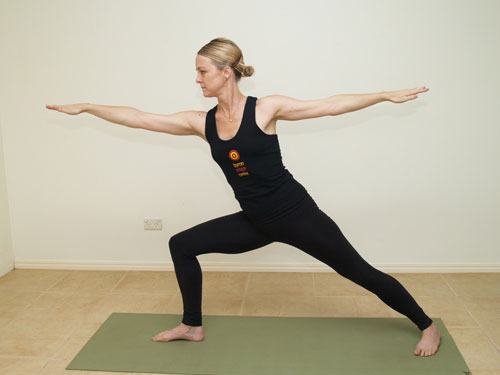
Maintain a Tadasana action in the torso by keeping the spine extended and vertical, with the armpits directly over the hip creases and stretch both sides of the torso evenly upward. A common misalignment is to tilt the torso in the direction of the front leg, like an over eager race horse ready to gallop off!
The expansion of the chest cavity is connected to the back leg – if the lift action in the back leg and knee drop, the chest will cave in.
Keep the abdominal organs lifted – as if you have an elastic band running from the pubic bone to the sternum which is drawing in firm.
Shoulders, Arms & Hands
With the arms in line at shoulder height and palms facing down, stretch both arms from shoulders to finger tips. Lengthen the inner arms while at the same time drawing the outer arm skin toward the shoulders.
Ideally there is a spiraling action taking place in the arms – the forearms are spiraling inwards so that the palms face the floor, while the upper arms are spiraling outwards, to broaden the collar bones and chest.
Draw the shoulders away from the ears, down the back, and forward. Broaden the collar bones side to side.
Extend back strongly through the rear arm.
Head and neck
The turn of the head is the final action of the pose – lengthen the back of the neck upward and turn the head to look out over the front arm.
Keep the brain passive and the breath even.
Sources:
1. Yoga The Path to Holistic Health, B.K.S Iyenger, Published by Dorling Kindersley Limited 2001
2. Yoga Anatomy, Leslie Kaminoff, Published by Human Kinetics 2007
